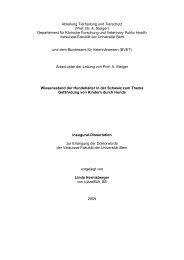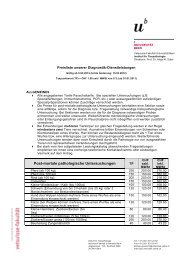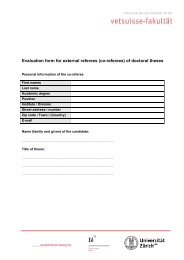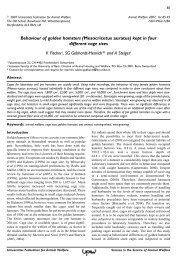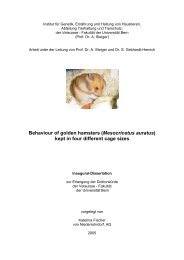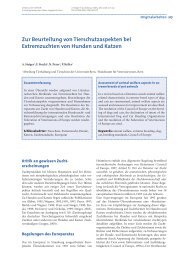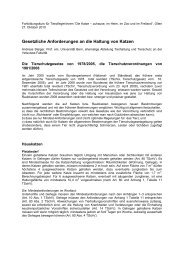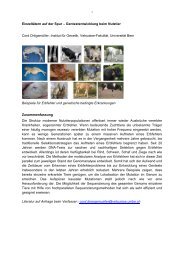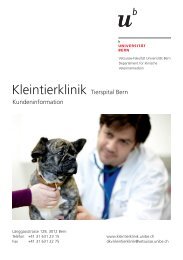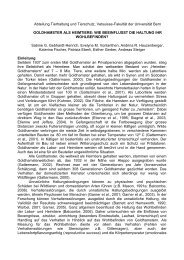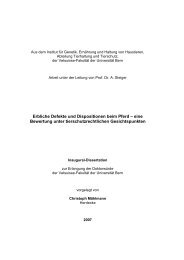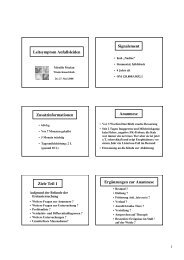Lifespan and Causes of Death in the Irish Wolfhound - Vetsuisse ...
Lifespan and Causes of Death in the Irish Wolfhound - Vetsuisse ...
Lifespan and Causes of Death in the Irish Wolfhound - Vetsuisse ...
Create successful ePaper yourself
Turn your PDF publications into a flip-book with our unique Google optimized e-Paper software.
3.5.2 Epizootology<br />
A prospective study <strong>of</strong> 177 <strong>Irish</strong> <strong>Wolfhound</strong>s, <strong>of</strong> which 10 developed GDV dur<strong>in</strong>g <strong>the</strong><br />
study time, found that <strong>the</strong> breed has a GDV <strong>in</strong>cidence <strong>of</strong> 2.6% per year, 3.6% <strong>in</strong><br />
males <strong>and</strong> 1.8% <strong>in</strong> females. The risk <strong>of</strong> GDV <strong>in</strong>creased by approximately 20% per<br />
additional year <strong>of</strong> age (Glickman, Glickman et al. 2000 a). On a more general note,<br />
older, large <strong>and</strong> giant purebred dogs with a deep <strong>and</strong> narrow thorax were found to be<br />
at an <strong>in</strong>creased risk (Burrows <strong>and</strong> Ignaszweski 1990).<br />
Gastric Dilation Volvulus (GDV) accounted for 11.7% <strong>of</strong> reported deaths <strong>in</strong> <strong>Irish</strong><br />
<strong>Wolfhound</strong>s (Bernardi 1986). The H<strong>of</strong>l<strong>in</strong> survey found a similar number <strong>of</strong> 11.5%<br />
(Prokopenko 1998). Contrary to o<strong>the</strong>r breed-specific diseases, <strong>the</strong> comparatively low<br />
lethality <strong>of</strong> GDV makes it difficult to assess its <strong>in</strong>cidence from death data as used <strong>in</strong><br />
<strong>the</strong>se studies as well as <strong>the</strong> study at h<strong>and</strong>.<br />
The author hypo<strong>the</strong>sises that to a certa<strong>in</strong> extent, <strong>the</strong> basic laws <strong>of</strong> mechanics <strong>and</strong><br />
<strong>in</strong>ertia could also be contribut<strong>in</strong>g to <strong>the</strong> higher GDV <strong>in</strong>cidence <strong>in</strong> large breed dogs:<br />
While <strong>the</strong> mass <strong>of</strong> <strong>the</strong> stomach <strong>in</strong>creases cubically – proportionally to its volume – as<br />
<strong>the</strong> dog's size <strong>in</strong>creases, <strong>the</strong> strength <strong>of</strong> its gastric ligaments only <strong>in</strong>creases<br />
quadratically – proportionally to <strong>the</strong>ir cross sectional area. Thus, <strong>the</strong> larger <strong>the</strong> dog<br />
grows, <strong>the</strong> less favourable <strong>the</strong> relation between stomach mass <strong>and</strong> ligament strength<br />
becomes.<br />
3.5.3 Heredity <strong>and</strong> Control Measures<br />
Hav<strong>in</strong>g a first-degree relative (parent/sibl<strong>in</strong>g/<strong>of</strong>fspr<strong>in</strong>g) with GDV has been associated<br />
with an <strong>in</strong>creased GDV risk for a long time. In a recent prospective study, dogs that<br />
had at least one first-degree relative affected with GDV had an adjusted risk <strong>in</strong>crease<br />
<strong>of</strong> 63%, <strong>in</strong>dicat<strong>in</strong>g a hereditary component. This hereditary component may be partly<br />
operat<strong>in</strong>g through <strong>in</strong>heritance <strong>of</strong> a particular body shape or temperament (Glickman,<br />
Glickman et al. 2000 b).<br />
The same study comes to <strong>the</strong> conclusion that dogs with a first-degree relative with<br />
GDV should not be used for breed<strong>in</strong>g, <strong>and</strong> that <strong>the</strong> <strong>in</strong>cidence <strong>of</strong> <strong>the</strong> disease could be<br />
reduced by 60% us<strong>in</strong>g this approach. Us<strong>in</strong>g a proportional hazard risk model, <strong>the</strong><br />
data also showed that a 14% overall decrease <strong>of</strong> GDV cases <strong>in</strong> <strong>the</strong> population could<br />
be reached by this selection approach (Glickman, Glickman et al. 2000 b).<br />
3.6 Rh<strong>in</strong>itis/Bronchopneumonia Syndrome – PCD<br />
3.6.1 Description<br />
Rh<strong>in</strong>itis/Bronchopneumonia syndrome is a disease <strong>of</strong> <strong>the</strong> respiratory tract that usually<br />
affects <strong>Irish</strong> <strong>Wolfhound</strong> puppies from <strong>the</strong> time <strong>of</strong> birth. O<strong>the</strong>r organs such as <strong>the</strong> bra<strong>in</strong><br />
ventricles, middle ear <strong>and</strong> male reproductive tract can also be affected. The<br />
syndrome was one <strong>of</strong> <strong>the</strong> earliest diseases described <strong>in</strong> <strong>the</strong> breed, back <strong>the</strong>n as<br />
probably viral <strong>in</strong> orig<strong>in</strong> (Wilk<strong>in</strong>son 1969). Only recently has <strong>the</strong> l<strong>in</strong>k been made to <strong>the</strong><br />
possible mechanisms <strong>of</strong> a hereditary immunodeficiency (Leisewitz, Spencer et al.<br />
1997) <strong>and</strong>/or <strong>of</strong> hereditary Primary Ciliary Dysk<strong>in</strong>esia (Clercx, Reichler et al. 2003;<br />
Casal 2004).<br />
31



